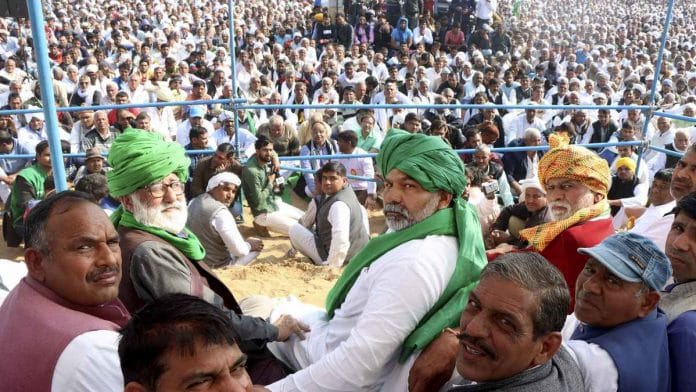New Delhi: With the agitation against the farm laws having lost a lot of popular support after violence erupted on the streets of Delhi on 26 January, there had been a spurt of khap panchayats in Haryana and western Uttar Pradesh as attempts were made to garner new support from the ground by certain farmer leaders.
Khap panchayats have often hogged the headlines owing mainly to certain controversial diktats passed against marriages conducted in the same gotra (clan). Those who support khap panchayats have often said that it is a misunderstood social institution while those opposing it have criticised it for not being modern enough in its thought process and decision-making.
The fact remains that outside certain rural parts of Haryana and western UP, there hasn’t been much understanding about the complex khap system and khap panchayats.
M.C. Pradhan’s The Political Systems of the Jats of Northern India (OUP, 1966) was probably the earliest systemic work on khap panchayats. He studied the khap panchayat of Baliyan gotra in Muzaffarnagar district of western UP.
“The clan and khap councils, so also the various lineage councils, are called to decide specific issues,” Pradhan wrote. “The judges on these councils are elected for a particular meeting and purpose and do not hold office on a permanent basis or for a prescribed term.”
The word khap was first used in the 1890-91 census report of Jodhpur, which was based on religion and caste. There is, however, not much authentic data available on khaps.
According to experts, the word khap is perhaps derived from the saka language word khatrap, which means an area inhabited by a particular clan. The political unit of khap is defined as a group of 84 villages (Khap Panchayat: Women and Honour Killing by Deepa Awasthi, Kalpaz Publications, 2016).
D.R. Chaudhary says in Khap Panchayat and Modern Age (National Book Trust, 2014) that the khap panchayat has no well-defined structure.
“It has no formal membership nor is there any elective principle to constitute it,” Chaudhary has written. “…the headship of khap is either hereditary or some elder is asked to preside over the meeting of a khap panchayat for the particular occasion only. A few more elders may be asked to act as panches (judges).”
More importantly, Chaudhary points out that earlier khap panchayats were not exclusively a Jat phenomenon, which they have become now.
“For instance, in its first sarv khap panchayat after independence in Sorem in the district of Muzaffarnagar of western UP held in 1950, Chaudhary Jawan Singh Gurjjar of the village Beenra Niwas was its pradhan, Thakur Yashpal Singh of village Puniala was up-pradhan, while Chaudhary Kabul Singh of village Sorem was its mantri,” Chaudhary has written. “Of the three office-bearers, Chaudhary Kabul Singh was the only Jat.”
Khaps, history and their role
According to Pradhan, three kinds of functions were performed by khap panchayats: “First, to settle disputes among members…secondly, it acted as a defender of the religious faith …thirdly, it had the responsibility to protect the khap area from outside invasion.”
Traditionally smaller issues are discussed by khap panchayats but if there is a bigger problem then a ‘Sarv Khap Panchayat (multi-clan council)’ is convened.
Earlier the word for convening a khap panchayat used to be spread orally but with advent of mobile phone technology, convening any such meeting has become much easier and can be done at a faster rate.
Although claims have been made that the institution of khap and khap panchayats date back to the time of Mahabharata, according to Chaudhary, “The earliest example of a Sarv Khap panchayat of Jats for which record is available was held at Barona (in present day Sonepat, Haryana) the Khera (the native village) of Dahiya Jats on March 7, 1911.”
This conclave passed 28 resolutions.
“Most of them dealt with social issues like promoting education, banning dance and obscene songs on the eve of marriage, giving alms to the needy, limiting the number of participants in a marriage party,” Chaudhary has written.
Some resolutions related to women, however, were controversial. They were considered by many as anti-women in their tone and tenor as they prescribed a certain dress code for women and prohibited them from going alone to the market.
To commemorate 100 years of this event, a similar gathering took place in 2011, which also passed 28 resolutions that addressed several social issues, including female foeticide.
“Sarv Khap’s information about their history is based on the unpublished handwritten pothi of Pandit Kanha Ram, resident of village Shauram in the district of Muzaffarnagar in western Uttar Pradesh. This pothi consists of 16 handwritten pages describing the dates and locations of Khap Panchayat’s meetings.” (Khap Panchayat: Women and Honour Killing by Deepa Awasthi, Kalpaz Publications, 2016).
Also read: How mahapanchayat in Haryana’s Jind could spell fresh trouble for BJP-JJP alliance
(The writer is research director with the Delhi-based think-tank Vichar Vinimay Kendra. He has authored two books on the RSS. Views expressed are personal)







In my opinion the writers referred herein or the writer of this article must have learners about the Khap Panchayats after invasion of Taimur Lung, donation to Khap Panchayats by Raja Surajmal and honour of Khap Panchayats by Babar. Records available in Soram.